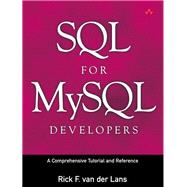Author Biography
Rick F. van der Lans is author of the classic Introduction to SQL, the definitive SQL guide that database developers have relied on for more than 20 years. He is a consultant, author, and lecturer specializing in database technology, development tools, data warehousing, and XML. As managing director of the Netherlands-based R20/Consultancy, he has advised many large companies on defining their IT architectures. He chairs the European Meta Data Conference, and writes columns for several magazines.
Table of Contents
| About the Author | p. xix |
| Preface | p. xx |
| Introduction | p. 1 |
| Introduction to MySQL | p. 3 |
| The Tennis Club Sample Database | p. 29 |
| Installing the Software | p. 37 |
| SQL in a Nutshell | p. 41 |
| Querying and Updating Data | p. 71 |
| Select Statement | |
| Common Elements | p. 73 |
| Select Statements | |
| Table Expressions, and Subqueries | p. 145 |
| Select Statement | |
| The From Clause | p. 171 |
| Select Statement | |
| The Where Clause | p. 213 |
| Select Statement | |
| Select Clause and Aggregation Functions | p. 315 |
| Select Statement | |
| The Group BY Clause | p. 349 |
| Select Statement | |
| The Having Clause | p. 375 |
| Select Statement | |
| The Order By Clause | p. 383 |
| Select Statement | |
| The Limit Clause | p. 395 |
| Combining Table Expressions | p. 409 |
| The User Variable and the SET Statement | p. 421 |
| The HANDLER Statement | p. 429 |
| Updating Tables | p. 437 |
| Loading and Unloading Data | p. 461 |
| Working with XML Documents | p. 471 |
| Creating Database Objects | p. 491 |
| Creating Tables | p. 493 |
| Specifying Integrity Constraints | p. 539 |
| Character Sets and Collations | p. 561 |
| The ENUM and SET Types | p. 577 |
| Changing and Dropping Tables | p. 591 |
| Using Indexes | p. 603 |
| Views | p. 631 |
| Creating Databases | p. 653 |
| Users and Data Security | p. 659 |
| Statements for Table Maintenance | p. 683 |
| The Show, Describe, and HELP Statements | p. 693 |
| Procedural Database Objects | p. 701 |
| Stored Procedures | p. 703 |
| Stored Functions | p. 745 |
| Triggers | p. 755 |
| Events | p. 767 |
| Programming with SQL | p. 783 |
| MySQL and PHP | p. 785 |
| Dynamic SQL with Prepared Statement | p. 807 |
| Transactions and Multiuser Usage | p. 815 |
| Syntax of SQL | p. 839 |
| Scalar Functions | p. 903 |
| System Variables | p. 953 |
| Bibliography | p. 963 |
| Index | p. 967 |
| Table of Contents provided by Publisher. All Rights Reserved. |
Supplemental Materials
The New copy of this book will include any supplemental materials advertised. Please check the title of the book to determine if it should include any access cards, study guides, lab manuals, CDs, etc.
The Used, Rental and eBook copies of this book are not guaranteed to include any supplemental materials. Typically, only the book itself is included. This is true even if the title states it includes any access cards, study guides, lab manuals, CDs, etc.








